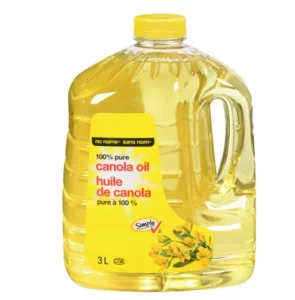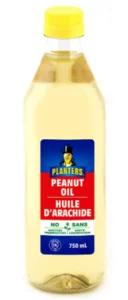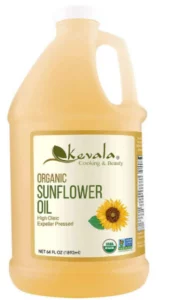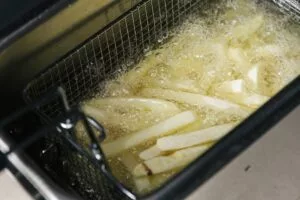
The Best Oil For Deep Frying
When it comes to comfort food, deep fried dishes rank among the best. Whether it be french fries, onion rings, or fried chicken, deep frying creates great tasting dishes. While fast food restaurants are the usual way people get deep fired foods, you can also make your own versions at home. One important part in the deep-frying process is the oil you use. Knowing which oil is the best for deep frying can be tricky. That is why we created this guide to list the best oil for deep frying. But before we get into our list, we will look at some things you should consider when buying an oil for deep frying.
Things to consider with deep frying oil
Smoke point: A smoke point is the temperature at which an oil will start to smoke. If an oil is heated past its smoke point, it will leave a burnt flavour to your food. More importantly, it could catch fire. Since deep frying requires you to cook at a high temperature, you should use an oil with a high smoke point. Unfortunately, an oil’s smoke point deteriorates over time as you expose it more to high heat.
Refinement: Refined oils have additional ingredients or chemicals added to them to increase shelf life and create a product that is uniform in taste, smell, and appearance. While refined oils are unhealthy compared to unrefined oils, they are more suitable for deep frying. This is because they have higher smoke points and are more stable under high temperatures. The colour of the oil will tell you how refined it is. Refined oils are light in colour.
Taste: Some oils, like sesame, avocado and extra-virgin olive oil has distinct flavours. If used in deep frying, these oils will transfer their flavours to your food. Chances are you do not want your food tasting like your cooking oil. That is why neutral tasting oils are preferred for deep frying. They preserve the flavour of your food.
Health: Since deep frying is not the healthiest cooking method, using a healthy cooking oil may be important to you. The key factor is how the oil balances its ratio of polyunsaturated fats (good fats) with saturated fats (bad fats). Ideally, you will want to pick an oil with a higher amount of polyunsaturated fats. Still, you will want an oil containing some saturated fats since they are more stable under high heat.
Cost: Lastly, cost is something you should consider when buying a cooking oil. Since deep frying requires large amounts of oil, you will need but a lot of it. If cost is an important factor for you, go with an oil that fits your budget. Healthier oils will usually cost more, while less healthy oils are cheaper.
Best oil overall
Canola oil
For the best overall oil for deep frying, we had to go with canola oil. It has a smoke point of 400˚F and is neutral in flavour. It also has a low level of saturated fats. Canola oil is one of the most affordable cooking oils available. For example, a 3 litre container of canola oil costs $14.49 at Loblaws. Compare that to a 750 mililitre bottle of avocado oil, which costs $16.49 at Loblaws.
Even though canola oil has a low amount of saturated fats, most are still heavily refined by manufacturers. This refinement foremoves many healthy nutrients. So, if you are more health consciousness, canola oil may not be the option for you. Still, the blend of a high smoke point, neutral taste, and affordable cost make canola oil one of the best for deep frying.
Pros
- Affordable price.
- Low in saturated fats.
Cons
- Highly refined, which means it does not have many nutrients.
The close second
Peanut oil is a close second for the best oil used in deep frying. It has a smoke point of 450˚F, making it one of the most stable oils around. There is a common myth that peanut oil will impart a nutty flavour to your food. The truth is that peanut oil has a light neutral flavour, and it will not leave a weird taste with your food. This oil is a favourite among foodies. On the Reddit page r/Cooking, several users listed peanut oil as the best option for deep frying. However, a big drawback for this oil is the risk of triggering peanut allergies. An easy solution is to use highly refined peanut oil. This version removes the protein that causes peanut allergies.
Pros
- Very stable due to its high smoke point.
Cons
- Must be aware of peanut allergies when using this oil.
A healthier option
Sunflower oil
If you are looking for a healthy deep-frying oil, then sunflower oil is a good option. Sunflower oil is very sustainable and has a smoke point of 450˚F. Sunflower oil is regarded as one of the best for maintain heart health because it is high in unsaturated fatty acids. With that being said, you should practice some caution when using sunflower oil for deep frying. This oil contains omega-6 fatty acids, which promote inflammation. Consuming large amounts of sunflower oil on a regular basis can cause inflammation in the body. Therefore, it is best to consume sunflower fired foods in moderation.
It should be noted that deep frying will always be an unhealthy cooking method, no matter the oil you use. Most of the nutritional benefits found in healthy oils will be lost when deep fried. Air frying is a better alternative to deep frying; you still get great tasting crispy food without the heavy use of oils. Still, sunflower oil is a healthy option to use when deep frying. It will not make it a healthier method overall, but it is a better option than hydrogenated oils packed with trans fats.
Pros
- High in unsaturated fats, which is better for your heart.
Cons
- High in omega-6 fatty acids, which can cause inflammation in the body.
Frequently asked questions about deep-frying oils
How do you deep fry food?
Deep frying can seem like a daunting process. It is true that deep frying requires attention and practice. But once you get the hang of it, deep frying at home can be fairly easy.
The first thing you should do is get the right cookware for deep frying. Countertop deep fryers are similar to the larger version found in restaurants. They are convenient and efficient, but they do take up kitchen space. Also, they are not necessary if you do not plan on deep frying regularly. You can use a large, deep pot as a deep fryer. This cast iron dutch oven by T-Fal is a good example. Other tools you will need are a wire basket, slotted metal spoon, or kitchen spider. These are used to lift or lower food into your deep fryer. To flip your food from a safe distance, select a pair of long tongs. And to sop up any remaining grease from your food, you can use a roll of paper towels.
Once you have gathered your cookware, select the oil you will use. Remember to pick an oil that has a high smoke point. Make sure to add plenty of oil to your deep fryer. You should pour enough in to fully submerge the food while leaving some room to cook.
The next step is to heat up the oil in your deep fryer. Most deep-fried recipes require the oil to be around 350-375˚F. You can use a digital thermometer to tell when the oil hits that temperature. A visual que is when the oil starts to give off visible waves of heat.
Once the oil reaches the required temperature, you can start dipping your food into the deep fryer. It is important to monitor the temperature of the oil as you cook. Adding food can lower the temperature of the oil by a few degrees. You can further lower the oil temperature by overcrowding the pot or adding cold food. If your oil temperature is too low, your food will be undercooked inside, while the outer layer will be overdone. To avoid this, cook in smaller batches and let foods come to room temperature.
Most recipes will have you fry the food until it has a crisp, golden brown exterior and is cooked through. Once your food is finished, use your preferred tool to remove it form the fryer and place it on paper towels to mop up an excess grease. If you are cooking multiple batches, take a slotted spoon and scoop out any remaining bits of food in the oil. Leaving food remnants in the oil can alter the taste of your next batch. Also, make sure to let the oil heat up again.
As you deep fry, be sure to practice safety at all times. That means giving your full attention to the fryer. Remember that water and oil are a bad combination. Adding water to hot oil can cause it to splatter or spill over, which can lead to nasty burns. To prevent this, wipe down wet utensils and pat down food to remove an excess moisture.
You can find many great deep-fried recipes online.
How do you dispose of deep-frying oil?
When you are finished with your deep fryer oil, the worse thing you could do is dumping it down the drain. The oil can block main sewer lines, which leads to sewer backups and expensive property damage. So, what are safe ways to dispose of deep-frying oil?
- Containers: The safest and easiest way to get rid of leftover oil is to pour it into a disposable container, like a glass jar or an old margarine tub. Just make sure that the oil is cool before pouring it into the container. Once the container is full, you can simply throw it away.
- Freezing: For this method, pour the leftover oil into a container and freeze it until the liquid hardens. The solid oil can then be scooped into the trash or recycle bin.
- Plastic bag: The last method is to toss cooled oil into a plastic trash bag already filled with garbage. The items will help soak up the grease. This method is the least effective one since it tends to be messy.
Before you start throwing out leftover oil, check with your local waste department to see if you need to follow any guidelines. Some cities have facilities where you can recycle leftover oil. For example, if you are disposing more than one litre of cooking oil, you will probably have to take it to an eco station.
Can you reuse deep-frying oil?
You do not have to throw out your oil every time you deep fry. It is perfectly fine to reuse your oil for deep frying. All you have to do is strain the oil through a filter or a few layers of cheesecloth to remove any leftover bits of food. Store the oil in an airtight container and keep it in a cool area of your kitchen. However, there is a limit to how many times you can reuse deep-frying oil. If the oil starts to smell rotten or rancid, it is not safe to use. Plus, oil deteriorates each time you reuse it. This increases the risk of it catching on fire. With these two caveats in mind, practise caution when reusing deep-frying oil.
How much oil do you need for deep frying?
For deep frying, you will need enough oil to completely submerge your food while leaving enough room to cook with. This means you will be using multiple cups or quarts of cooking oil.
Read more

The Best Oven Proof Pans in Canada
If your looking to improve your cooking skills, then this buying guide is for you.

The Best Canadian Vodka
Canadian vodka is a unique spirit. Here are some of the best brands.
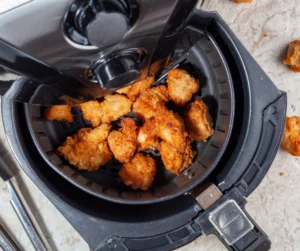
Are Air Fryers Worth It? Here Are The Pros and Cons
Air fryers display more advantages than disadvantages: The convenience and healthy factors outweigh any negative one.

The Best Soda Makers in Canada
Save some money while enjoying fresh soda or sparkling water with some of the best soda makers available in Canada.
